The Munich Bikeability Index: A Practical Approach for Measuring Urban Bikeability
Abstract
1. Introduction
2. State-of-the-Art Bikeability
2.1. Measuring and Modeling Bikeability
2.1.1. The Copenhagenize Index
- Lobbying of non-governmental organizations (NGOs);
- Bicycle culture (how well are bicycles established among citizens);
- Bike facilities (availability of parking spaces, ramps, designated spaces in trains;
- Bicycle infrastructure;
- Bike-sharing programs;
- Gender split (percentage of men and women that use bicycles);
- Modal split;
- Modal split increase of bikes since 2006;
- Safety perception (the perception that cycling is safe);
- Politics (political involvement in promoting bikeability);
- Social acceptance (feelings of car drivers towards cyclists);
- Urban planning;
- Traffic abatement (efforts that have been made to implement slow traffic zones);
- Freight bicycles and logistics.
2.1.2. Bicycle Level of Service
2.1.3. The “ADFC Fahrradklimatest” in Germany
- Cycling and traffic climate;
- Safety for cyclists;
- Family friendliness;
- Comfort for cyclists;
- Infrastructure and network of designated bike paths;
- Status of bicycle traffic.
2.1.4. Bikeability Index Dresden
- Bicycle infrastructure (bike paths and lanes);
- Existence of structurally-separated bike paths;
- Green area and water surface;
- Topography;
- Land use;
- Bicycle facilities;
- Traffic load.
2.2. Theoretical Approaches of Bikeablity Indices and Literature Classification
3. Case Study in Munich, Germany
- Existence and type of bike path;
- Speed limit;
- Parking facilities for bicycles;
- Quality of intersection infrastructure for bicycles.
3.1. The Investigation Area for Testing Bikeability Estimation
3.2. Methodological Approach
3.3. Inspected Parameters and Resulting Map Views
4. Discussion
5. Conclusions and Outlook
Author Contributions
Funding
Institutional Review Board Statement
Informed Consent Statement
Data Availability Statement
Acknowledgments
Conflicts of Interest
Appendix A. Evaluation Scales (Cursive Combination Not Present in the Testing Area)
| Type of Street or Cycling Infrastructure | Abbreviation in Attribute Table | Value (1–10) |
|---|---|---|
| Broad bike path, both-sided | RWb | 10 |
| Broad and narrow bike path | RWb_RWs | 9 |
| Narrow bike path, both-sided | RWs | 8 |
| Cycling street | FS | 7 |
| Narrow bike path and bike lane | RWs_RS | 7 |
| Bike lane, both-sided | RS | 6 |
| Advisory bike lane, both-sided | SSt | 5 |
| Regular street | None | 3 |
| One-way street, open | EBo | 3 |
| One-way street with advisory bike lane | EB_RS | 3 |
| Maximum Speed | Value (1–10) |
|---|---|
| 30 km/h | 10 |
| 50 km/h | 7 |
| Type of Parking Facility | Value (1–10) |
|---|---|
| Bike Locker | 10 |
| Roofed bike rack | 8 |
| Regular bike rack | 6 |
| No bike rack | 2 |
| Type of Intersection | Abbreviation in Attribute Table | Value (1–10) |
|---|---|---|
| Traffic light width biking box | BB | 9 |
| Designated cycling traffic light | FA | 6 |
| Traffic light with visual markers on the ground | LSA_M | 6 |
| Regular traffic light | LSA | 3 |
| Regular intersection without traffic lights | none | 3 |
References
- Karanikola, P.; Panagopoulos, T.; Tampakis, S.; Tsantopoulos, G. Cycling as a smart and green mode of transport in small touristic cities. Sustainability 2018, 10, 268. [Google Scholar] [CrossRef]
- Faghih-Imani, A.; Anowar, S.; Miller, E.J.; Eluru, N. Hail a cab or ride a bike? A travel time comparison of taxi and bicycle-sharing systems in New York City. Transp. Res. Part A Policy Pract. 2017, 101, 11–21. [Google Scholar] [CrossRef]
- Horton, D. Environmentalism and the bicycle. Environ. Politics 2006, 15, 41–58. [Google Scholar] [CrossRef]
- Christensen, H.R. Is the Kingdom of bicycles rising again? Cycling, gender, and class in postsocialist China. Transfers 2017, 7, 1–20. [Google Scholar] [CrossRef]
- De Nazelle, A.; Nieuwenhuijsen, M.J.; Antó, J.M.; Brauer, M.; Briggs, D.; Braun-Fahrlander, C.; Cavill, N.; Cooper, A.R.; Desqueyroux, H.; Fruin, S. Improving health through policies that promote active travel: A review of evidence to support integrated health impact assessment. Environ. Int. 2011, 37, 766–777. [Google Scholar] [CrossRef] [PubMed]
- Pucher, J.; Buehler, R. Making cycling irresistible: Lessons from the Netherlands, Denmark and Germany. Transp. Rev. 2008, 28, 495–528. [Google Scholar] [CrossRef]
- Lee, J.-S.; Jiang, J.-W. Enhanced fuzzy-logic-based power-assisted control with user-adaptive systems for human-electric bikes. IET Intell. Transp. Syst. 2019, 13, 1492–1498. [Google Scholar] [CrossRef]
- Gössling, S. Urban transport justice. J. Transp. Geogr. 2016, 54, 1–9. [Google Scholar] [CrossRef]
- Rietveld, P. Biking and Walking: The Position of Non-Motorized Transport Modes in Transport Systems. In Handbook of Transport Systems and Traffic Control; Button, K.J., Hensher, D.A., Eds.; Emerald Group Publishing Limited: Bingley, UK, 2001. [Google Scholar]
- Hoedl, S.; Titze, S.; Oja, P. The bikeability and walkability evaluation table: Reliability and application. Am. J. Prev. Med. 2010, 39, 457–459. [Google Scholar] [CrossRef]
- Winters, M.; Teschke, K.; Brauer, M.; Fuller, D. Bike Score®: Associations between urban bikeability and cycling behavior in 24 cities. Int. J. Behav. Nutr. Phys. Act. 2016, 13, 18. [Google Scholar] [CrossRef]
- Krenn, P.J.; Oja, P.; Titze, S. Development of a bikeability index to assess the bicycle-friendliness of urban environments. Open J. Civ. Eng. 2015, 5, 451. [Google Scholar] [CrossRef]
- Merriam-Webster.com. Available online: https://www.merriam-webster.com/dictionary/bikeability (accessed on 31 March 2019).
- Oxforddictionaries.com. Available online: https://en.oxforddictionaries.com/definition/bikeable (accessed on 31 March 2019).
- Lowry, M.B.; Callister, D.; Gresham, M.; Moore, B. Assessment of communitywide bikeability with bicycle level of service. Transp. Res. Rec. 2012, 2314, 41–48. [Google Scholar] [CrossRef]
- Festa, D.C.; Forciniti, C. Attitude towards bike use in Rende, a small town in south Italy. Sustainability 2019, 11, 2703. [Google Scholar] [CrossRef]
- Mora, R.; Moran, P. Public Bike Sharing Programs under the Prism of Urban Planning Officials: The Case of Santiago de Chile. Sustainability 2020, 12, 5720. [Google Scholar] [CrossRef]
- Shaaban, K. Why Don’t People Ride Bicycles in High-Income Developing Countries, and Can Bike-Sharing Be the Solution? The Case of Qatar. Sustainability 2020, 12, 1693. [Google Scholar] [CrossRef]
- Nielsen, T.A.S.; Skov-Petersen, H. Bikeability—Urban structures supporting cycling. Effects of local, urban and regional scale urban form factors on cycling from home and workplace locations in Denmark. J. Transp. Geogr. 2018, 69, 36–44. [Google Scholar] [CrossRef]
- Di Mascio, P.; Fusco, G.; Grappasonni, G.; Moretti, L.; Ragnoli, A. Geometrical and functional criteria as a methodological approach to implement a new cycle path in an existing urban road network: A case study in Rome. Sustainability 2018, 10, 2951. [Google Scholar] [CrossRef]
- Shui, C.; Chan, W. Optimization of a bikeway network with selective nodes. Sustainability 2019, 11, 6531. [Google Scholar] [CrossRef]
- Keler, A.; Schmiedlau, F.; Grigoropoulos, G. Evaluating bicycle traffic efficiency using bicycle traffic counts at sparse locations in cities-comparing NYC with Munich. In Proceedings of the GISRUK 2020-28th GIS Research UK Conference, London, UK, 21–23 June 2020. [Google Scholar]
- Lin, S.-J.; Shyu, G.-S.; Fang, W.-T.; Cheng, B.-Y. Using multivariate statistical methods to analyze high-quality bicycle path service systems: A case study of popular bicycle paths in Taiwan. Sustainability 2020, 12, 7185. [Google Scholar] [CrossRef]
- Ryu, S. A Bicycle Origin–Destination Matrix Estimation Based on a Two-Stage Procedure. Sustainability 2020, 12, 2951. [Google Scholar] [CrossRef]
- Hardinghaus, M.; Papantoniou, P. Evaluating Cyclists’ Route Preferences with Respect to Infrastructure. Sustainability 2020, 12, 3375. [Google Scholar] [CrossRef]
- Yao, Y.; Zhang, Y.; Tian, L.; Zhou, N.; Li, Z.; Wang, M. Analysis of Network Structure of Urban Bike-Sharing System: A Case Study Based on Real-Time Data of a Public Bicycle System. Sustainability 2019, 11, 5425. [Google Scholar] [CrossRef]
- Boettge, B.; Hall, D.M.; Crawford, T. Assessing the Bicycle Network in St. Louis: A PlaceBased User-Centered Approach. Sustainability 2017, 9, 241. [Google Scholar] [CrossRef]
- Furth, P.G.; Mekuria, M.C.; Nixon, H. Network Connectivity for Low-Stress Bicycling. Transp. Res. Rec. 2016, 2587, 41–49. [Google Scholar] [CrossRef]
- Useche, S.; Montoro, L.; Alonso, F.; Oviedo-Trespalacios, O. Infrastructural and human factors affecting safety outcomes of cyclists. Sustainability 2018, 10, 299. [Google Scholar] [CrossRef]
- Ul-Abdin, Z.; De Winne, P.; De Backer, H. Risk-perception formation considering tangible and non-tangible aspects of cycling: A flemish case study. Sustainability 2019, 11, 6474. [Google Scholar] [CrossRef]
- Shaaban, K.; Abdur-Rouf, K. Assessing Walking and Cycling around Schools. Sustainability 2020, 12, 10607. [Google Scholar] [CrossRef]
- Vasilev, M.; Pritchard, R.; Jonsson, T. Trialing a Road Lane to Bicycle Path Redesign—Changes in Travel Behavior with a Focus on Users’ Route and Mode Choice. Sustainability 2018, 10, 4768. [Google Scholar] [CrossRef]
- Nikitas, A. How to save bike-sharing: An evidence-based survival toolkit for policy-makers and mobility providers. Sustainability 2019, 11, 3206. [Google Scholar] [CrossRef]
- Sun, Y.; Mobasheri, A.; Hu, X.; Wang, W. Investigating impacts of environmental factors on the cycling behavior of bicycle-sharing users. Sustainability 2017, 9, 1060. [Google Scholar] [CrossRef]
- Macioszek, E.; Świerk, P.; Kurek, A. The Bike-Sharing System as an Element of Enhancing Sustainable Mobility—A Case Study based on a City in Poland. Sustainability 2020, 12, 3285. [Google Scholar] [CrossRef]
- Lee, K.; Chae, J.; Kim, J. A courier service with electric bicycles in an Urban Area: The case in Seoul. Sustainability 2019, 11, 1255. [Google Scholar] [CrossRef]
- Copenhagenize_Design_Company. The Copenhagenize Bicycle Friendly Cities Index. 2017. Available online: http://copenhagenizeindex.eu/about.html (accessed on 31 March 2019).
- Kazemzadeh, K.; Laureshyn, A.; Winslott Hiselius, L.; Ronchi, E. Expanding the Scope of the Bicycle Level-of-Service Concept: A Review of the Literature. Sustainability 2020, 12, 2944. [Google Scholar] [CrossRef]
- Adfc.de. ADFC-Fahrradklima-Test. 2018. Available online: https://www.fahrradklima-test.de/ (accessed on 31 March 2019).
- McHarg, I.L.; History, A.M.O.N. Design with Nature; American Museum of Natural History: New York, NY, USA, 1969. [Google Scholar]
- Tomlin, C.D. Map algebra: One perspective. Landsc. Urban Plan. 1994, 30, 3–12. [Google Scholar] [CrossRef]
- Gehring, M.S.D.B. Bikeability—Index für Dresden—Wie Fahrradfreundlich ist Dresden? Available online: https://tud.qucosa.de/api/qucosa%3A30317/attachment/ATT-0/ (accessed on 31 March 2019).
- Jonietz, D.; Timpf, S. Entwicklung eines GIS-basierten Bikeablity-Index am Beispiel der Stadt Augsburg. In Geoinformatik; Shaker: Aachen, Germany, 2012; pp. 83–90. [Google Scholar]
- Zhu, S.; Zhu, F. Cycling comfort evaluation with instrumented probe bicycle. Transp. Res. Part A Policy Pract. 2019, 129, 217–231. [Google Scholar] [CrossRef]
- Gholamialam, A.; Matisziw, T.C. Modeling bikeability of urban systems. Geogr. Anal. 2019, 51, 73–89. [Google Scholar] [CrossRef]
- Geofabrik.de. Available online: https://download.geofabrik.de/europe/germany/bayern/oberbayern.html (accessed on 31 March 2019).
- Wahlgren, L.; Schantz, P. Bikeability and methodological issues using the active commuting route environment scale (ACRES) in a metropolitan setting. BMC Med. Res. Methodol. 2011, 11, 6. [Google Scholar] [CrossRef]
- Fraser, A. An Empirical Study of Bicyclists’ Turning Behaviour at Signalized Intersections. Master’s Thesis, University of Waterloo, Waterloo, ON, Canada, 23 August 2018. [Google Scholar]
- Mayfield, C.J.; Kumler, M.; Afzalan, N. Automating the Classification of Thematic Rasters for Weighted Overlay Analysis in GeoPlanner for ArcGIS. Master’s Thesis, University of Redlands, Redlands, CA, USA, February 2016. [Google Scholar]
- Kunstareal—Modifizierte Alternative 5 Im 3. Stadtbezirk Maxvorstadt. Available online: https://www.muenchen-transparent.de/dokumente/3651443 (accessed on 31 March 2019).
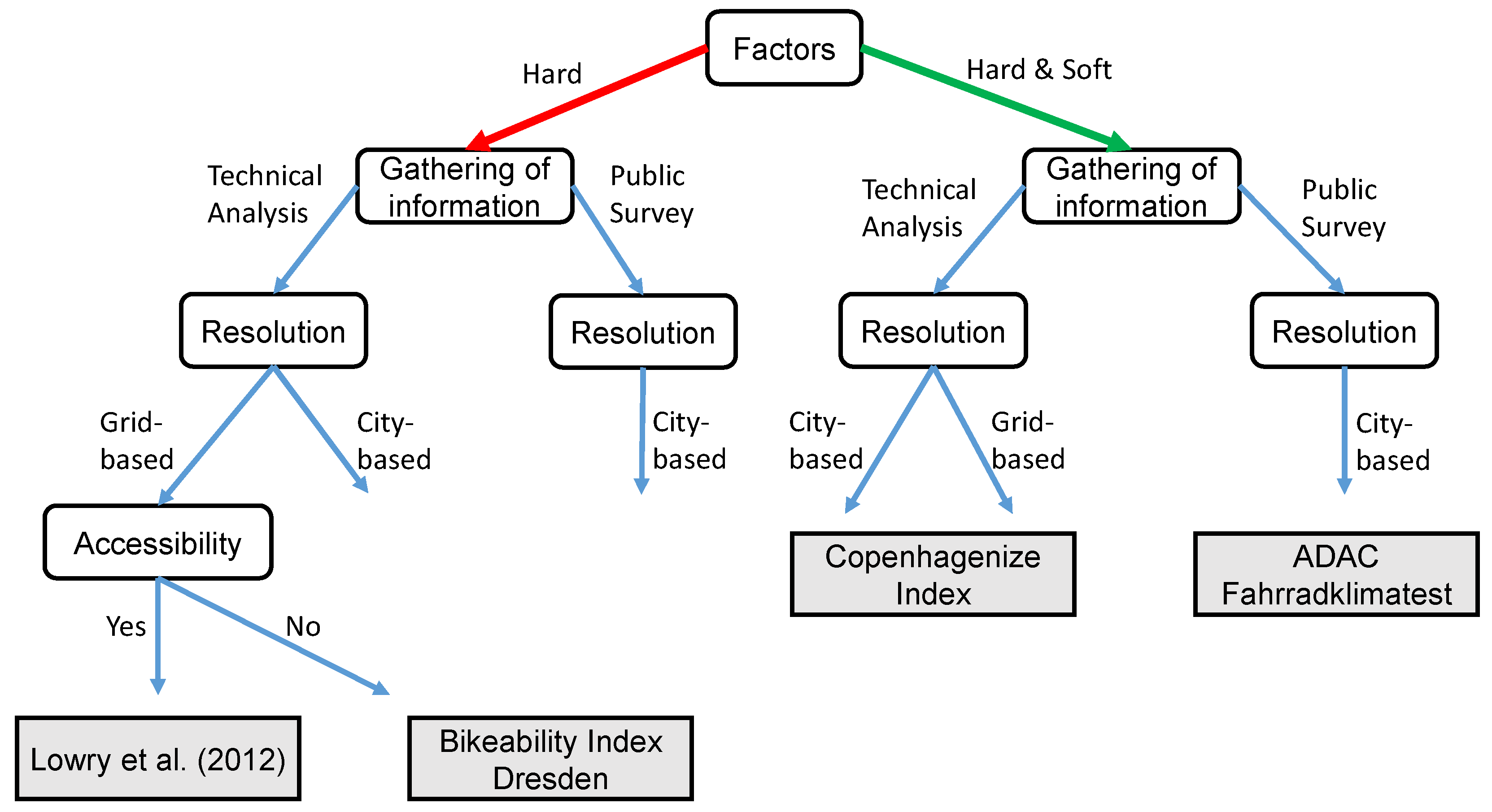
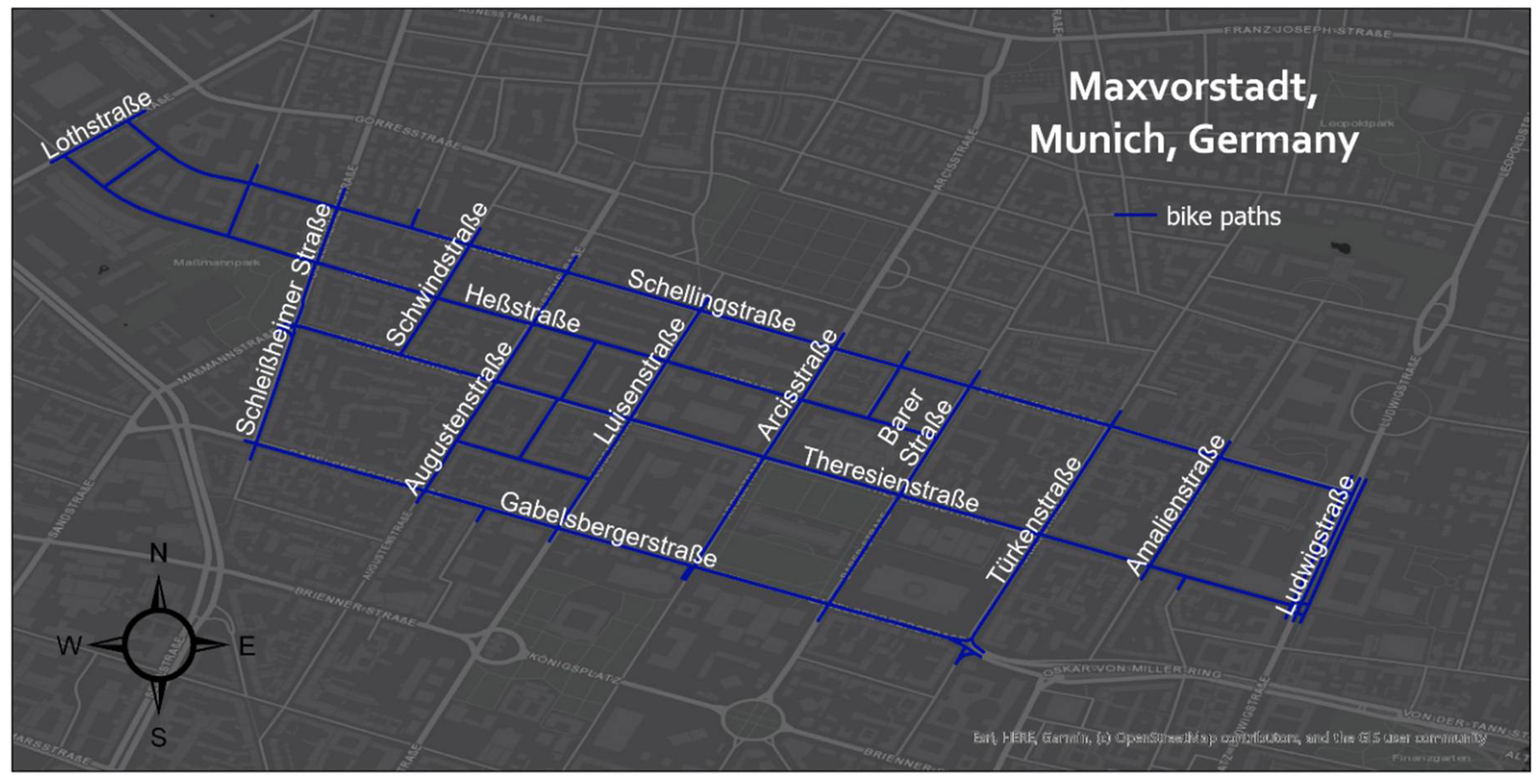


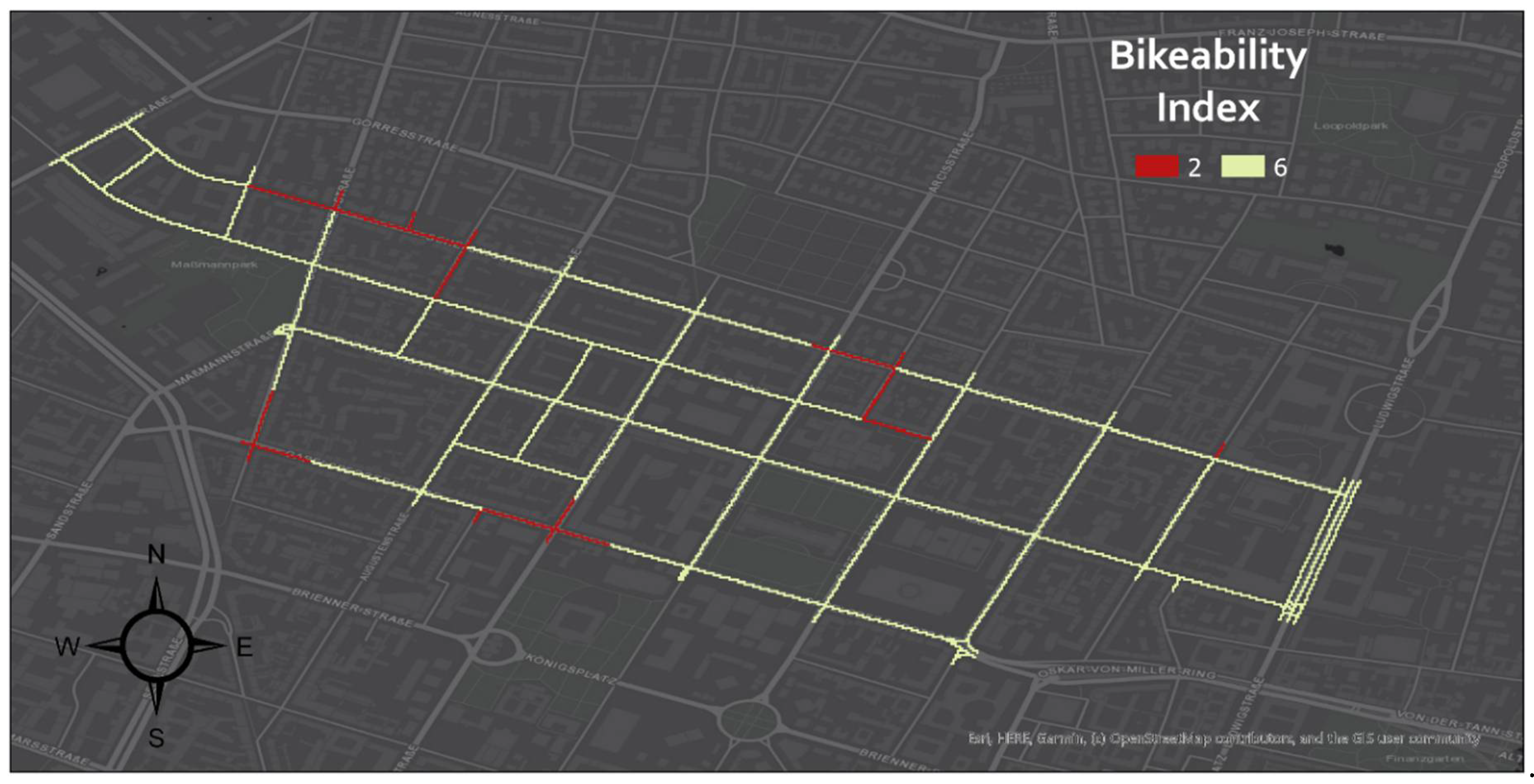
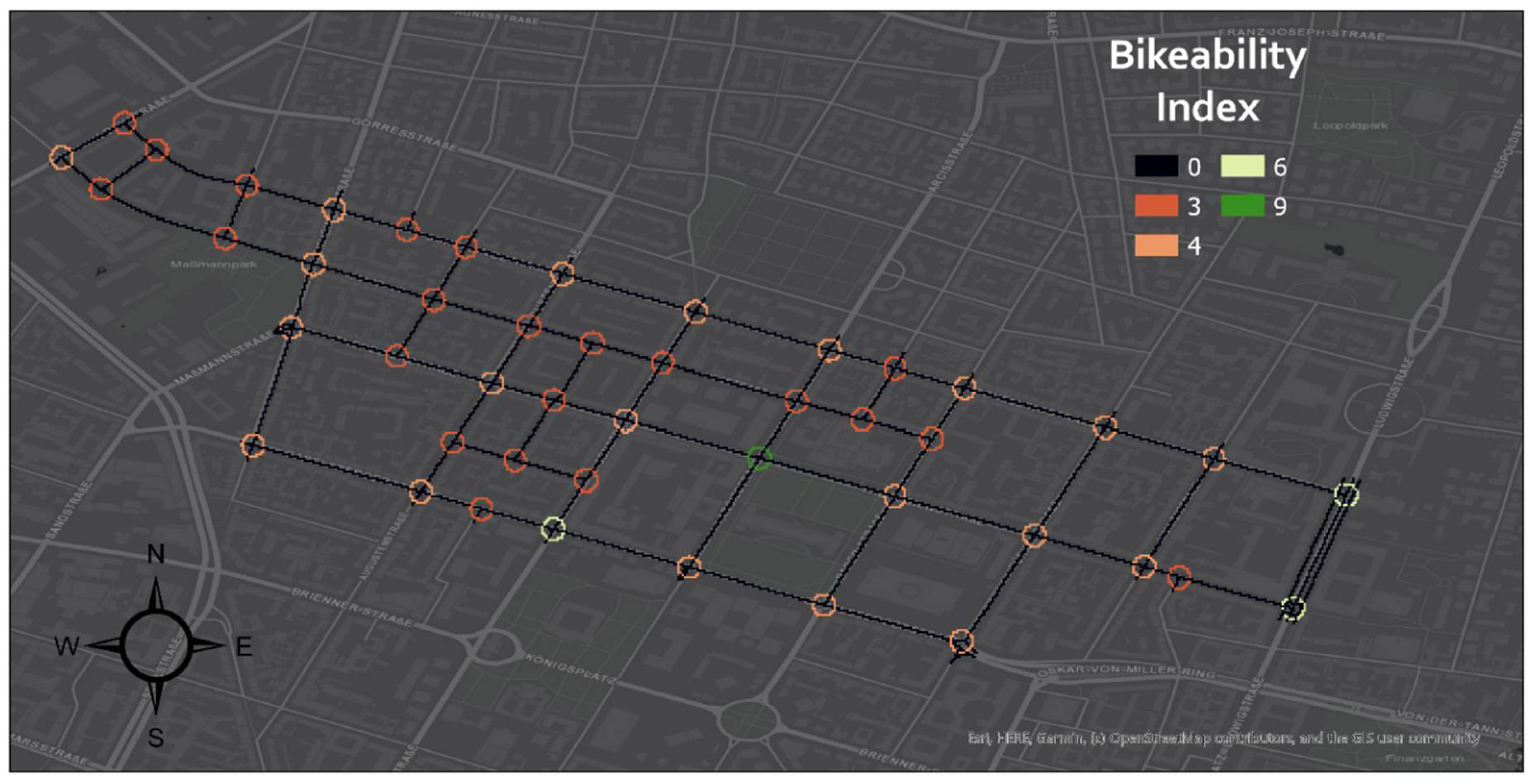

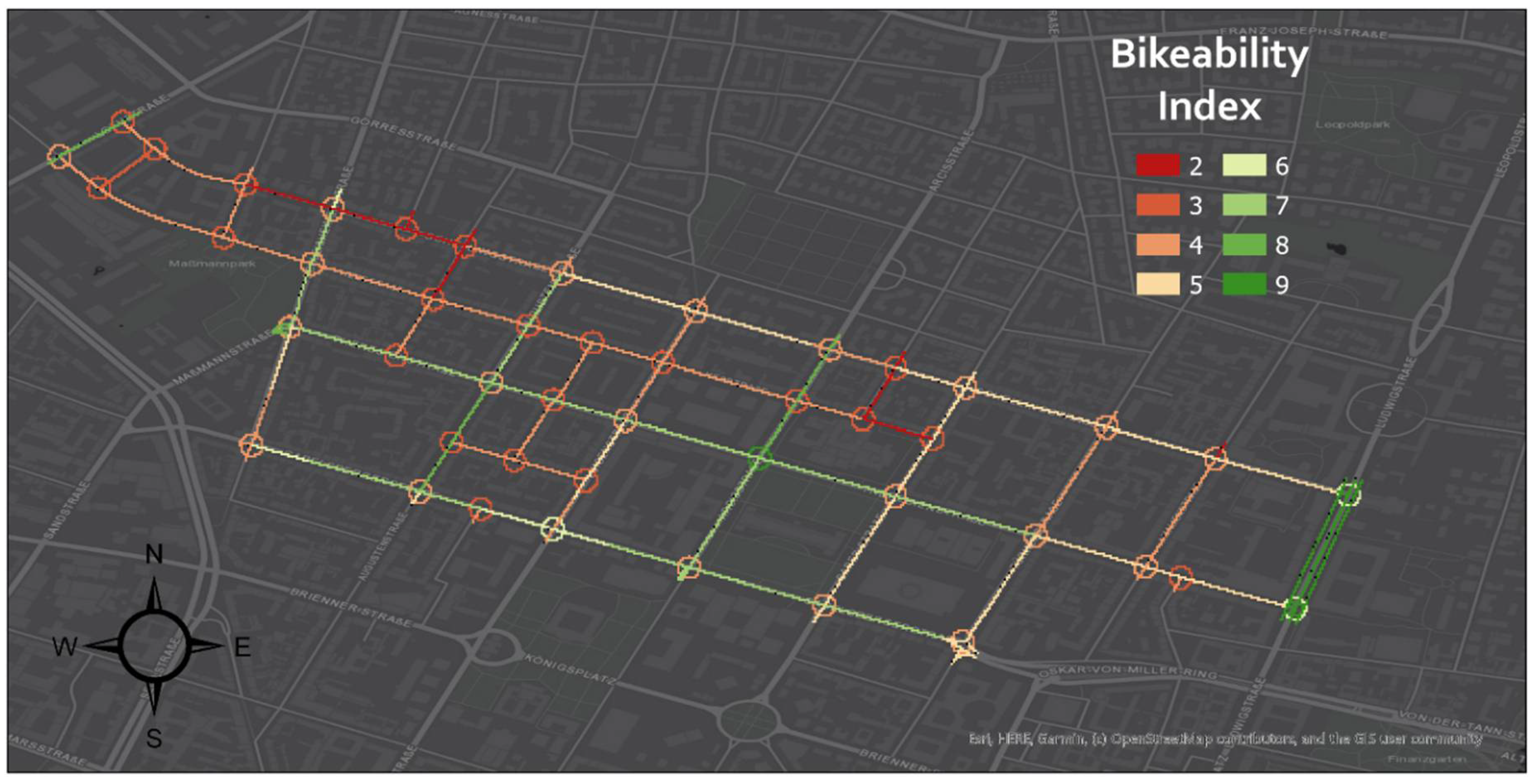
Publisher’s Note: MDPI stays neutral with regard to jurisdictional claims in published maps and institutional affiliations. |
© 2021 by the authors. Licensee MDPI, Basel, Switzerland. This article is an open access article distributed under the terms and conditions of the Creative Commons Attribution (CC BY) license (http://creativecommons.org/licenses/by/4.0/).
Share and Cite
Schmid-Querg, J.; Keler, A.; Grigoropoulos, G. The Munich Bikeability Index: A Practical Approach for Measuring Urban Bikeability. Sustainability 2021, 13, 428. https://doi.org/10.3390/su13010428
Schmid-Querg J, Keler A, Grigoropoulos G. The Munich Bikeability Index: A Practical Approach for Measuring Urban Bikeability. Sustainability. 2021; 13(1):428. https://doi.org/10.3390/su13010428
Chicago/Turabian StyleSchmid-Querg, Jonas, Andreas Keler, and Georgios Grigoropoulos. 2021. "The Munich Bikeability Index: A Practical Approach for Measuring Urban Bikeability" Sustainability 13, no. 1: 428. https://doi.org/10.3390/su13010428
APA StyleSchmid-Querg, J., Keler, A., & Grigoropoulos, G. (2021). The Munich Bikeability Index: A Practical Approach for Measuring Urban Bikeability. Sustainability, 13(1), 428. https://doi.org/10.3390/su13010428






